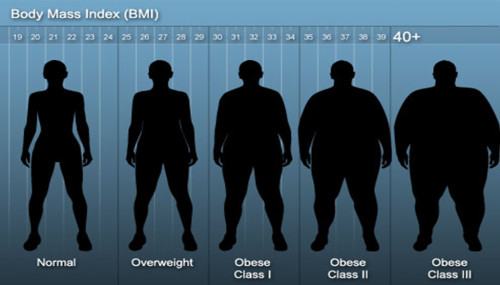The easiest way of finding out if your weight is healthy is to compare your weight to your height. This can be done using Body Mass Index (BMI).
How to weigh yourself correctly
Take your weight first thing in the morning on an empty stomach in minimal clothing, emptying your bladder and in bare feet. Measure your weight in kilograms (1.0kg = 2.2 lbs)
How to measure your height correctly
Stand tall in your bare feet, looking straight ahead with your feet together and heels against a wall. Have a friend gently lower a ruler down on your head and then mark your height on the wall with a light pencil. Use a measuring tape and measure your height in metres.
How to calculate your Body Mass Index (BMI)
BMI = Weight (kilograms) Height (metres)2
Work out your height in metres and multiply the figure by itself e.g. 1.6m x 1.6m = 2.56m2
Measure your weight in kilograms e.g. 65kg
Divide the weight by the height squared (ie. the answer to Q1) eg.2.56 = 25.4kg/m2
So what does your BMI mean?
□ Less than 18.5kg/m2 is underweight
□ 18.5 – 24.9kg/m2 is a healthy norma
□ 25 – 29.9kg/m2 is overweight
□ Greater than 30kg/m2 is obese
Being underweight is linked with health problems such including osteoporosis, infertility, lung disease etc
A normal BMI means that your weight is healthy and at this weight you are at the lowest risk of disease and death
Being overweight increases your risk of Type II diabetes, high blood pressure, heart disease, stroke, gallbladder disease and certain types of cancer
Being obese means that you are also at risk of the same diseases previously mentioned but your risk of disease and death is greater
Remember:
BMI is not a flawless system for assessing weight for height. BMI cannot distinguish between fat and muscle nor can it take into account your frame size. This is why BMI is not applicable to the following groups of people: sports people; pregnant women; children and the elderly. Nonetheless for the general population, it is a valuable tool for assessing weight for height
For people over 65 years of age a BMI at the higher end of normal is advisable
What is waist circumference?
Waist circumference measures the amount of fat around your waist and can help determine your disease risk. A high waist circumference can increase your risk of developing Type II diabetes, heart disease and high blood pressure
How to measure your waist circumference
Find the top of your hip bone, preferably on the right hand side
Use a measuring tape to measure around your waist at this point
The tape should be snug but not cause an indent or mark your skin
Take the measurement at the end of your normal breath
Write down the measurement in centimetres or inches
So what does it mean?
For men – greater than or equal to 94cm or 37 inches shows increased risk and greater than or equal to 102cm or 40 inches shows substantial risk
For women – greater than or equal to 80cm or 32 inches shows increased risk and greater than or equal to 88cm or 35 inches shows substantial risk
What about apple and pear shapes?
Apple-shaped people carry most of their excess body fat around their middle or waist, while pear-shaped people carry most of their excess body fat on their hips, buttocks and thighs. Apple shaped people are more likely to develop diabetes, heart disease, stroke and high blood pressure than pear-shaped people. Men are usually apple shaped whereas women are pear shaped, but after the menopause changes in hormones cause excess body fat to develop around the middle or waist of women.



Post your comment